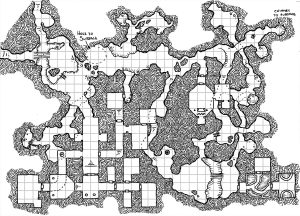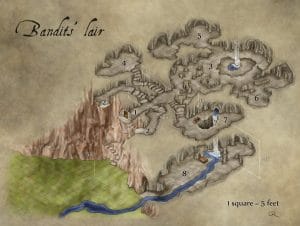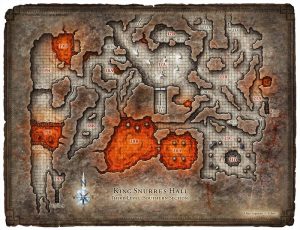I was rereading White Plume Mountain, the classic Dungeons and Dragons adventure and was reminded at just how random the whole thing felt. Don’t get me wrong, in my retrospective of it, I still consider it one of the all time best D&D modules. But White Plume Mountain–just like anything that is 40 years old–feels a little creaky in places. Indeed, tastes change and younger, hipper models always bursts onto the scene at some point.
But what does it mean that tastes have changed as it relates to the classic “dungeon crawls” of Dungeons and Dragons? Well, the way adventure writers approach dungeons has changed, that’s what. Let’s talk about this some.

*gasp* Sometimes dungeons don’t even exist in newer games! In the early days of D&D, the story of an adventure might simply be that you’ve stumbled upon a cellar door, so get down there and kill some monsters to take their loot. That type of adventure doesn’t require much more than a few connected rooms scribbled on a piece of graph paper.
And it’s not the kind of thing you roleplay, you know? Newer adventures might be primarily intrigue, mystery, or it simply might be that a setting doesn’t take a group underground much. Therefore, an adventure written nowadays might see a character go several levels without a sustained dungeon crawl.
Randomness has been replaced with a more story-driven approach. Today’s greater emphasis on roleplaying goes hand-in-hand with a more story-driven approach. Those old school dungeons seemed to be plopped down pretty much in any ‘ole place, and you certainly didn’t need a reason to enter. You just did, you know, because there was looting to be done.
Adventures nowadays have stories that lead characters to certain locales (A cave! A dragon’s lair! Ruins! Abandoned mines!), and those locales have have everything to do with the story. And if you loot something? Well, it’s gear that’s related to…you guess it, the story.

(Here’s where I go slightly cranky old man. While I’m 100% in the camp of a storytelling approach, I’m also an admitted hacker and slasher, so there are occasional moments where I’ll listen to someone pontificate endlessly about the preciousness of the story and I’m quietly thinking to myself Can we roll initiative now? How ’bout now?)
Where did those monsters go to the bathroom? Provided the story even leads a party to a dungeon, the dungeon itself has gotten a much needed facelift over the years. There has been a distinct trend the the past several decades of fantasy and science fiction to add a level of plausibility to our fictional worlds.
Whereas older dungeons just seemed tacked together, newer dungeons strive for a logic. Older dungeons might have a room with a bugbear, a room with a zombie, then a NPC in the next, and writers wouldn’t even spare a thought for how those creatures co-existed, much less why they were down there in the first place.
But if you are alive, you eat. So newer dungeons take care to place a stack of provisions in the corner if there is a group of pirates living there, for example. They’ll have a water source. (So if a clever adventuring party wants to poison the watering hole to soften up the enemy? Well, give them some XP.) Even more, the story will often give purpose to why the creatures were in the dungeon in the first place.

Linear progression has been replaced by the illusion of full choice. In RPG terms, you’ll often see this explain via therms “railroad” versus “sandbox.” In some ways I can be an old school dungeon hugger, as I liked the way games seemed to advance more quickly back in the day.
It used to be that you cleared a dungeon one room at a time, then checked for traps and moved to the next room. You might have a choice of left or right, but even then, you’d know that both directions would lead you to the main boss. This was linear, or “railroad” as it’s called today.
Today’s “sandbox” dungeons give the players the impression that they can tackle the dungeons in whatever direction or order that their hearts desire. You might have 3 or 4 different ways to enter the dungeon. The main boss might not be in the last room. Newer dungeons feel more open-ended with many more player options available to them, this in addition to the logic that we talked about above.
But really, where did those monsters go to the bathroom? I, for one, celebrate the newer nuanced approach to adventure writing, even if I can be nostalgic from time to time. Newer dungeons are much less confusing, yet they are no less torturing. And our games are better for it.
[ninja-inline id=10231]

